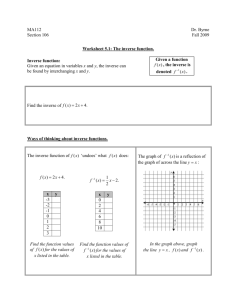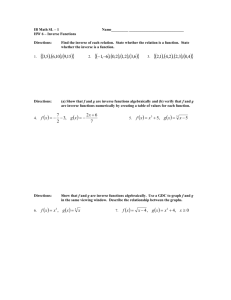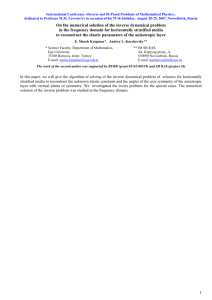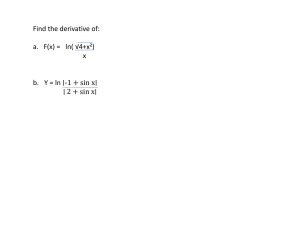Section1.3notesLarsonSupplemental
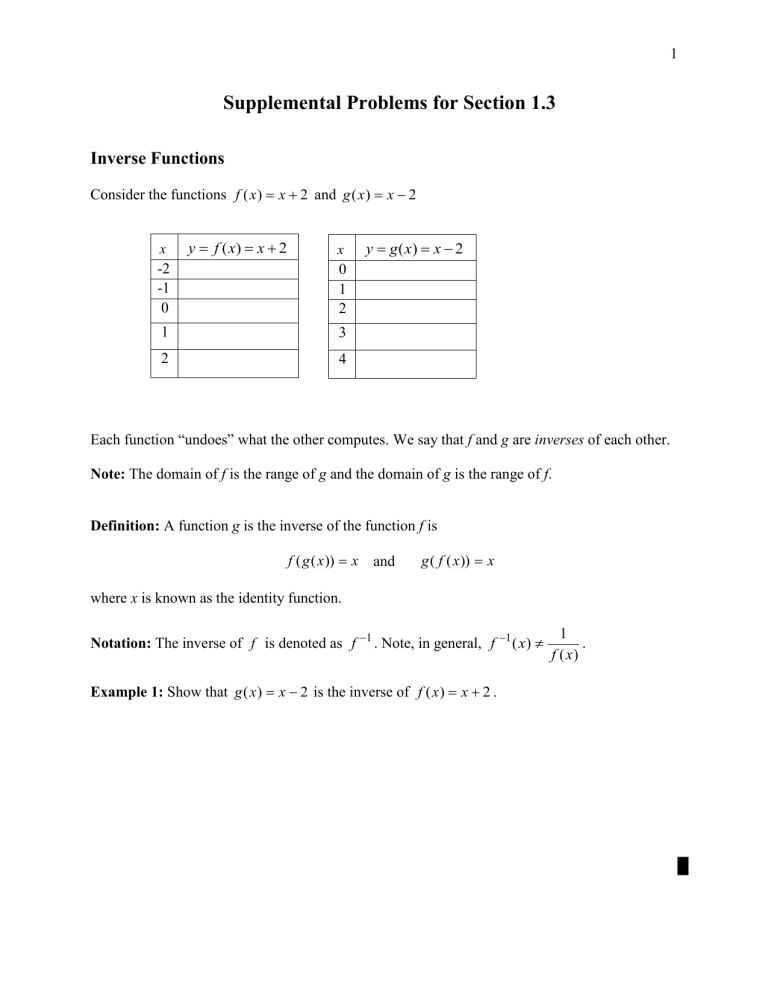
Inverse Functions
Consider the functions
Supplemental Problems for Section 1.3 f ( x )
x
2 and g ( x )
x
2 x y
f ( x )
x
2 x y
g ( x )
x
2
-2 0
-1
0
1
1
2
3
2 4
Each function “undoes” what the other computes. We say that f and g are inverses of each other.
Note: The domain of f is the range of g and the domain of g is the range of f .
Definition: A function g is the inverse of the function f is f ( g ( x ))
x and g ( f ( x ))
x where x is known as the identity function.
Notation: The inverse of f is denoted as f
1
. Note, in general, f
1
( x )
1 f ( x )
.
Example 1: Show that g ( x )
x
2 is the inverse of f ( x )
x
2 .
1
█
2
Note: The graph of f
1
is the reflection of the graph of f across the line y
x .
Reflective Property of Inverse Functions: The graph of f contains the point ( a , b ) if and only if the graph of f
1
contains the point ( b , a ) .
For example, consider the graph of f ( x )
x
2 and its inverse f
1
( x )
x
2 .
Example 1: Sketch the graph of the inverse of the following function
3
Example 2: If f ( x )
12 x
5 , find f
1
(
6 )
█
█
4
Example 3: If f ( x )
x x
5
8
, find f
1
(
7 )
Example 4: If f ( x )
3
5 x
4 e x
, find f
1
( 7 )
█
█
5
Note: N ot all functions have an inverse.
Consider f ( x )
x
2
Fact: A function f has an inverse if and only if it is one to one , which says each y value in its range has a unique value x in its domain assigned to it.
For example, y
4 f ( x )
x
2
is not one-to-one. Consider the value in the range of
. Then for both x
2 and x
2 , f ( x )
x
2
given by x
2
f (
2 )
(
2 )
2
4 x
2
f ( 2 )
( 2 )
2
4
The range value of y
4 has two x values, x
2 and x
2 , in the domain that the function f ( x )
x
2
assigns to it. To be one-to-one, the each range value can only have one value x in the domain assigned to it. This leads to the following test for determining if a function has an inverse
Horizontal Line Test
A function is one-to-one and hence has an inverse if and only if every horizontal line intersects the graph at most once.
6
However, an inverse can be defined for a function without an inverse in some cases by restricting its domain.
For example, consider f ( x )
x
2
defined for the domain x
0 .
Example 5: Determine whether the function 2 t
2
4 is one-to-one and hence as an inverse.
Solution: Using Maple plot(2*t^2 + 4, t = -2..2);
7
Example 6: Determine whether the function 2 t
2
4 , t
0 is one-to-one and hence as an inverse.
█
Solution:
> plot(2*t^2 + 4, t = 0..4);
█
Example 7: Determine whether the function cos( x ) , 0
x
is one-to-one and hence as an inverse.
Solution: > plot(cos(x), x = 0..Pi);
8
Example 8: Determine whether the function 8 sin( x )
3 cos( 10 x ) is one-to-one and hence as an
█ inverse.
Solution: > plot(8*sin(x)-3*cos(10*x), x = -2*Pi..2*Pi);
█
9
Procedure for Finding an Inverse Function
1. Solve for x as a function of y .
2. Interchange x and y . The resulting equation is f
1
( x ) .
Example 8: Find the inverse of the function f ( x )
5 x
3 .
Solution:
Example 9: Find the inverse of the function f ( x )
6
x
2
, x
0 .
Solution:
█
█
Example 10: Find the inverse of the function f ( x )
x
1
3
.
Solution:
Example 10: Find the inverse of the function f ( x )
12 x
3
4 .
Solution: We start by assigning y
f ( x )
12 x
3
4 and solve the equation for x using the following procedure.
12 x
3
4
y
10
█
12 x
3 y
4 x
3 y
4
12 x
3 y
4
12
Switching x and y gives the inverse function f
1
( x )
3 x
4
.
12
█
Example 10: Find the inverse of the function f ( x )
2 e
11 e x x
5
12
.
Solution: We start by assigning y
f ( x )
2 e
11 e x x
5
12
and solve the equation for x using the following procedure.
2 e x
11 e x
5
12
y (Set function equal to y )
11
2 e x
5
y ( 11 e x
12 ) (Multiply both sides by 11 e x
12 )
2 e x
5
11 ye x
12 y (Distribut e the y )
2 e x
11 ye x
12 y
5 (Isolate the e x on left hand side of equation )
( 2
11 y ) e x
12 y
5 (Factor e x
) e x
12
2
y
11
5 y
(Divide both sides by 2
11 y ) ln e x ln
12 y
2
11
5 y
(Take ln of both sides ) x
ln
12
2
y
5
11 y
(Use fact that ln e x x ln e
x ( 1 )
x to solve for x )
Switching x and y gives the inverse function f
1
( x )
ln
12 x
2
5
11 x
.
12
█



